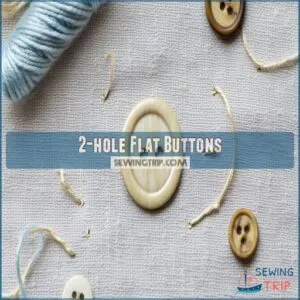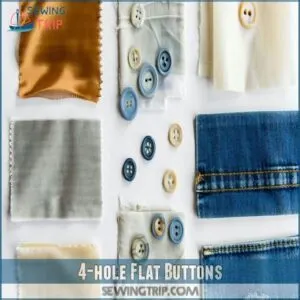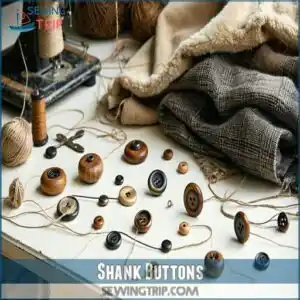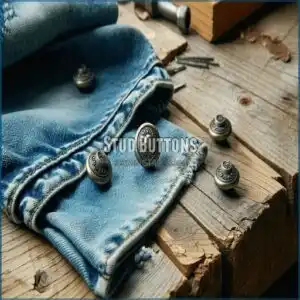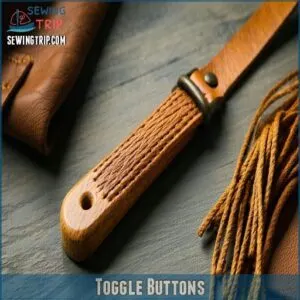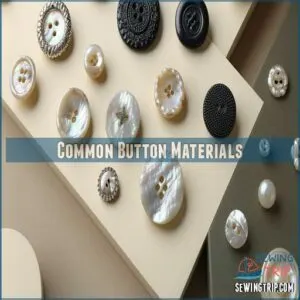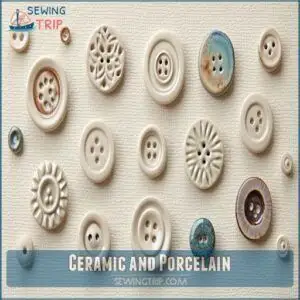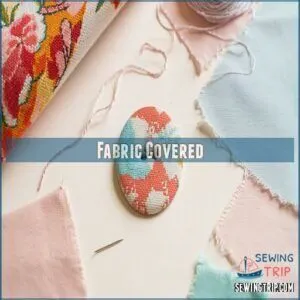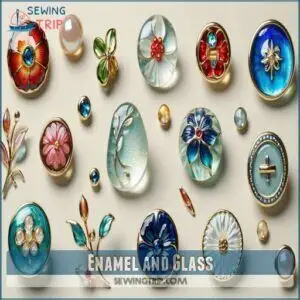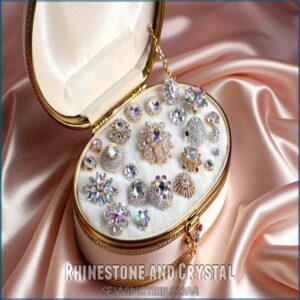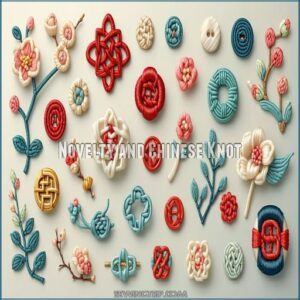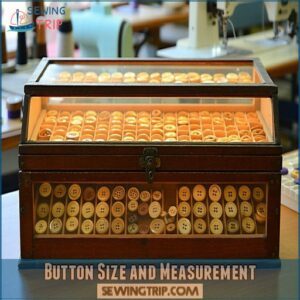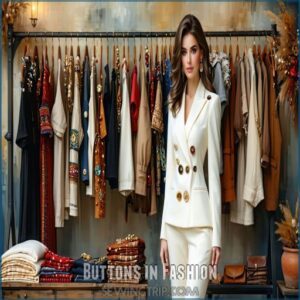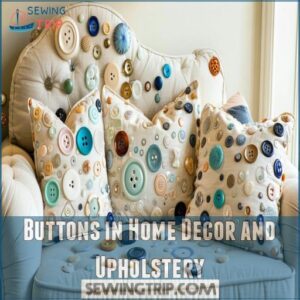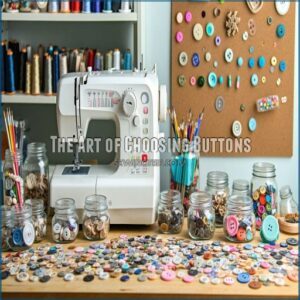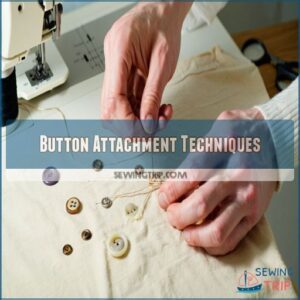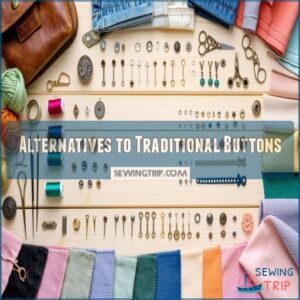This site is supported by our readers. We may earn a commission, at no cost to you, if you purchase through links.
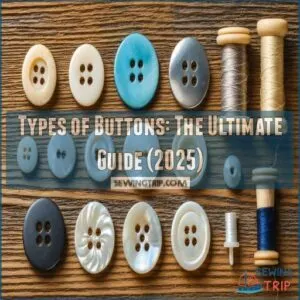
You’ve got 2-hole and 4-hole flat buttons, perfect for shirts and dresses, while shank buttons step up for thicker fabrics like wool.
Stud buttons mean serious business on denim, and toggle buttons add charm to coats and jackets.
From practical plastic and hardy metal to luxurious mother of pearl or rustic wood, there’s a button for every mood and material.
Want to mix it up? Snap buttons or Velcro bring modern alternatives.
Ready to learn which types of buttons suit your projects?
Table Of Contents
- Key Takeaways
- Historical Evolution of Buttons
- Button Styles and Their Functions
- Common Button Materials
- Specialty and Decorative Buttons
- Button Size and Measurement
- Buttons in Fashion
- Buttons in Home Decor and Upholstery
- The Art of Choosing Buttons
- Button Attachment Techniques
- Alternatives to Traditional Buttons
- Frequently Asked Questions (FAQs)
- Conclusion
Key Takeaways
- You’ll find buttons in all shapes, sizes, and materials, each designed for specific fabrics and styles. From flat and shank buttons for shirts and coats to toggles and studs for a rugged look, the right button elevates your project.
- Button material matters. Plastic and polyester offer versatility, wood and coconut bring natural charm, while metal, horn, mother-of-pearl, and shell add elegance. Corozo and bone offer sustainable options.
- Consider the weight of your fabric when choosing buttons. Lightweight fabrics pair well with small, delicate buttons, while heavier fabrics need sturdier options. Color coordination and design also play a crucial role in your final selection.
- You can attach buttons using various techniques, including sewing flat buttons, attaching shank buttons, and securing stud buttons. Alternatives like snaps, Velcro, zippers, and hook-and-eye closures offer diverse fastening options.
Historical Evolution of Buttons
Ever wondered how those little fasteners on your clothes came to be? Discover the journey of buttons from handmade objects to mass-produced necessities in modern fashion.
From Handmade to Mass-Produced
The fascinating journey of button making spans millennia.
Before the Industrial Revolution dramatically altered production methods, buttons were painstakingly handcrafted, showcasing remarkable craftsmanship evolution.
Imagine painstakingly carving a button from bone or shell – a true indication of artistry and patience!
These early buttons, crafted from natural materials like bone, shell, and ivory, often served as status symbols, not just closures.
Understanding the various button types is essential to appreciating the evolution of button making and its impact on the fashion industry.
The Industrial Revolution revolutionized button manufacturing techniques.
Suddenly, materials like glass and porcelain became readily available, and mass production techniques made types of buttons accessible to everyone.
This shift in production methods democratized fashion, allowing people from all walks of life to adorn their clothing with a variety of button materials.
The industrial impact on button making was profound, transforming it from a specialized craft to a booming industry.
This era also witnessed a burst of creativity in button designs, ranging from simple to ornate, reflecting evolving societal trends and personal styles.
The Industrial Revolution Impact
During the Industrial Revolution, buttons got a major upgrade.
Thanks to mass production techniques and machine sewing, factory workers churned out buttons faster and cheaper than ever before.
New materials like wood and early versions of plastic emerged, paving the way for the versatile polyester buttons we’re familiar with today.
The history of button making reveals that buttons have been manufactured from almost every possible material.
Industrial growth also popularized secure options like 4-hole flat buttons, perfect for durability, and shank buttons, ideal for thicker fabrics, gained their iconic status too.
This era didn’t just modernize buttons—it made them accessible to everyone, transforming them from luxury items into everyday essentials, a true fashion game-changer.
Button Styles and Their Functions
Buttons aren’t just functional—they add character and versatility to your clothing and accessories.
From simple two-hole designs to decorative toggles, each style serves a specific purpose while shaping your garment’s look and feel.
2. hole Flat Buttons
2-hole flat buttons might seem simple, but they pack versatility. They’re lightweight champions, working great for shirts, dresses, and even light coats.
Sewn through two tidy holes, they’re easy to attach and blend beautifully into garments. Plus, their flat designs work wonders on button holes and fabrics of varying weights.
For crafting or sewing projects, exploring button options can help find the perfect fit.
- Ideal for light to medium-weight fabric choices.
- Easier sewing techniques.
- Available in countless button types and sizes.
- Works perfectly for fabric-covered buttons designs.
- Adds subtle, timeless charm.
4. hole Flat Buttons
4-hole flat buttons are versatile champions in button designs, perfect for neat and secure finishes. Their flat designs work seamlessly on all fabrics from silk to denim.
The use of flat buttons is essential for achieving professional-looking results.
- Sewing Techniques: Their four sew-through holes make button placement sturdy and steady.
- Fabric Choices: From light shirts to heavy coats, they complement all.
- Button Measurement: Available in endless button sizes, they fit everything from collars to cuffs.
Shank Buttons
Shank buttons bring a timeless charm to garments, great for both function and flair.
Featuring a raised button shank, they’re ideal for thicker fabrics like wool or fur. Unlike flat buttons, their small loop or hole allows easy sewing while reducing fabric strain.
From heavy coats to delicate decorative shanks on blouses, these buttons match style with practicality. Available in designs like wooden shank buttons or sleek metal ones, they offer durability and elegance, perfect for adding polished touches to custom garments.
For those looking to purchase shank buttons, there are numerous options to choose from, catering to various tastes and sewing needs.
Stud Buttons
Stud buttons, often called denim fasteners, are a go-to choice for jeans hardware and other rugged garments.
Their unique characteristic is that they don’t require sewing – they’re attached using screw fixings or are pressed into place with specialized tools, which makes them particularly durable.
If you’ve ever marveled at how your jeans withstand daily wear and tear, you’ve got stud buttons to thank.
Their strong, circular design with a sturdy shank makes them perfect for denim pants, jackets, and overalls.
Plus, they add serious durability without sacrificing style since brands often emboss them for a personalized touch.
Whether you’re revamping vintage denim or designing workwear, stud buttons flawlessly merge function and flair as the unsung heroes of Button History and utilize metal buttons in their construction.
Toggle Buttons
If shank buttons offer a touch of elegance, toggle buttons bring functionality with flair.
These fasteners stand out with their elongated, cylindrical shapes and are perfect for thicker fabrics like coats and jackets.
Often paired with loops or leather straps, toggle buttons offer a rustic charm while keeping things practical.
Typically made from wood, horn, or plastic, their unique shape makes them a favorite among designers.
Looking for fastener options? Toggle types add fresh character, standing apart from snap buttons or other classic button types.
Common Button Materials
In the case of buttons, the material matters as much as the design.
From durable plastic to elegant mother of pearl, each one brings its own style and purpose to your garments.
Plastic and Polyester
Plastic buttons and polyester buttons are fantastic for their versatility, affordability, and polished looks.
These modern buttons made from synthetic materials are everywhere, from casual shirts to high-end suits. Their eco-friendly versions are even gaining popularity!
What’s great? You’ve got plenty of options.
- Durable and easy to clean – They handle wear and washing well.
- Wide design options – Perfect for any style.
- Budget-friendly – Stylish without breaking the bank!
Wood and Coconut
Bring a touch of nature to your wardrobe with wooden buttons and coconut shell buttons. These eco-friendly options combine style and sustainability effortlessly.
- Wood Buttons: Durable and versatile, perfect for rustic and vintage looks.
- Coconut Shell Buttons: Lightweight yet sturdy, ideal for tropical vibes.
- Sustainable Buttons: Made from natural materials, Earth-conscious and timeless.
- Unique Designs: Each button’s natural texture tells a story, adding character to any outfit.
Metal and Horn
Metal buttons and horn buttons bring elegance and durability to clothing.
Metal buttons, crafted through metal stamping using materials like brass or stainless steel, suit coats, jackets, and denim.
They offer a variety of stylish shapes, from round to logo designs.
Horn buttons, stemming from horn crafts like horn polishing, feature natural patterns ideal for high-end garments like blazers.
Both types pair well with light to heavy fabrics.
Their timeless appeal enhances button making for fashionable and functional designs.
For those looking to give new life to old clothing, learning about reuse jeans button techniques can be a valuable skill in extending the life of denim garments.
Mother of Pearl and Shell
Let’s talk about the elegance of mother of pearl buttons and shell buttons, handpicked for their natural iridescent finishes.
These stunning accents bring a dash of oceanic charm to shirts, dresses, and more.
- Luxury Embellishments: Perfect for formalwear.
- Durable Beauty: Resistant to wear.
- Oceanic Inspirations: Timeless shell crafts for casual elegance.
Swap plastic for lasting sophistication with these treasures!
Corozo and Bone
Explore the eco-friendly world of corozo buttons and bone buttons, two standout types of buttons crafted from sustainable materials.
Corozo, often called "vegetable ivory," comes from the tagua palm nut and boasts impressive button durability and natural grain.
Bone crafting, steeped in history, delivers sleek, sturdy options perfect for timeless designs.
Both materials are versatile, offering sizes and styles that balance nature and elegance—a thoughtful alternative to mass-produced plastic and even mother of pearl buttons.
Specialty and Decorative Buttons
Specialty and decorative buttons let you add that extra spark to your clothing or craft projects.
Whether you’re after a touch of elegance or a quirky statement, these unique designs bring personality to any piece.
Ceramic and Porcelain
Ceramic and porcelain buttons are like tiny pieces of wearable art, blending durability with sophistication.
Made through a detailed clay modeling and firing process, these decorative buttons bring a polished, timeless quality to garments or home projects.
Here are three reasons ceramic and porcelain buttons deserve your attention:
- Strength That Lasts: These ceramic buttons aren’t just pretty—they’re tough.
- Rich Colors and Glazes: From soft pastels to bold hues, glaze techniques create colors that pop and complement any design.
- Unique Textures: Porcelain buttons offer smooth, refined surfaces, while ceramic art variations feature artistic textures, perfect for personalized touches.
Whether for clothing or décor, they’re a creative, elegant choice!
Fabric Covered
Fabric-covered buttons bring charm and creativity to your wardrobe.
These textile buttons let you upcycle fabric scraps, turning them into elegant covered fasteners perfect for matching outfits.
Whether you prefer bold patterns or sleek solids, fabric wrapping provides endless options.
Their sewn overlays offer a polished touch, and the process is surprisingly simple.
Fabric buttons add a custom flair that elevates any garment effortlessly, proving functionality and style go hand in hand.
Enamel and Glass
Enamel buttons and glass buttons are showstoppers in the context of decorative buttons.
With their enamel coating, vintage enamel designs flaunt bold colors and intricate enamel art, perfect for stylish accents.
Glass buttons, known for their delicate beauty and glass etching, bring a subtle elegance that shines in formal wear like wedding dresses.
Both materials suit decorative or functional uses, from vibrant enamel buttons in casual looks to transparent glass buttons for heirloom-worthy pieces.
These button materials effortlessly combine durability and sophistication for unique looks.
Rhinestone and Crystal
If you’re looking for that extra pop of class, rhinestone buttons and crystal buttons are your answer.
These decorative buttons add sparkle effects that elevate anything, from wedding gowns to home decor.
Available in various colors, sizes, and rhinestone settings, they’re versatile luxury fasteners for unique projects.
Whether round, flower-shaped, or bold gemstone buttons, they bring glamour to accessories or garments.
- Why you’ll love them:
- Transform plain fabrics into dazzling creations.
- Add a touch of elegance to DIY designs.
- Effortlessly amplify formal or festive looks.
Novelty and Chinese Knot
Novelty buttons add personality to garments, with a standout option being Chinese knot buttons—fancy fasteners crafted from woven cords.
These decorative buttons, inspired by Chinese embroidery, feature knot designs like straight or flowery patterns.
They’re functional yet artistic, commonly adorning traditional attire.
Novelty materials such as horn, plastic, or metal broaden creative possibilities, transforming simple garments into decorative accents.
Whether you prefer bold button designs or intricate Chinese knot buttons, these decorative buttons offer endless opportunities for flair.
| Type | Material | Use | Style | Features |
|---|---|---|---|---|
| Chinese Knot Buttons | Cotton Cord | Traditional Wear | Flowery Knot | Functional & Artistic |
| Button Knot Clasps | Elastic Cord | Casual Clothing | Sliding Knots | Adjustable |
| Plastic Novelty | Resin | Kids’ Clothing | Cartoon Shapes | Lightweight |
| Horn Buttons | Horn | Coats & Jackets | Natural Texture | Strong & Durable |
| Fabric Covered Buttons | Fabric | Custom Designs | Soft Texture | Seamless Look |
Button Size and Measurement
Regarding button sizes, understanding measurements like lignes can make all the difference in getting the right fit for your project.
With a quick glance at a size chart, you’ll guarantee your buttons aren’t too big, too small, or just plain off.
Understanding Lignes
Button measurement relies on "lignes," an important unit for accurate button sizing.
One ligne equals 1/40th of an inch (0.635mm).
Here’s the breakdown:
- Size Conversion: Multiply the ligne value by 0.635 for millimeters.
- Ligne Calculation: Divide millimeters by 0.635 to get lignes.
- Button Sizing: Consider fabric weight when choosing button sizes for secure button attachment techniques.
- Metric Systems: Lignes offer a bridge between metric and imperial units for button sizes.
Size Charts and Standardization
Ever feel lost in button sizes?
Button size charts simplify button sizing, ensuring accurate size conversion and understanding button sizes.
They standardize button measurement, bridging metric standards with the size of traditional buttons.
Whether your project involves delicate silk or sturdy denim, the button size chart helps you select the perfect button sizes based on fabric thickness.
Buttons in Fashion
You’ll find buttons on everything from jeans to wedding dresses, and they’re more than just closures.
They can completely change a look, adding a pop of personality or a touch of elegance.
Buttons for Shirts
After mastering button sizes, let’s talk shirt buttons. They’re not just closures; they’re style accents! Consider these button types for shirts: two-hole flat buttons (classic and versatile), four-hole flat buttons (extra secure), and shank buttons (for a raised look).
Materials range from basic plastic to elegant mother-of-pearl. Think about color too:
- Collar buttons often match the shirt.
- Cuff fasteners can add a pop of contrast.
- Placket buttons are usually functional and subtle.
Shirt button holes, yoke buttons, and even cufflink buttons all play a role. Choose wisely!
Buttons on Coats
Consider coat buttons your outerwear accessories–they’re more than just coat fasteners.
For wool coats, horn, bone, or hefty metal buttons for coats add a touch of class. Think toggles for a duffle coat or sleek shank buttons for a fitted look.
Need winter buttons for a parka? Opt for durable plastic or metal. Don’t forget, the right buttons on coats can elevate your style.
Matching buttons to fabric weight matters. A heavy winter coat needs sturdy buttons, not delicate seashells, and it’s about finding the right buttons that complement the coat.
Buttons for Pants and Jeans
From the custom lines of a coat, let’s slide down to the rugged world of pants and jeans. Buttons here aren’t just functional; they’re a statement. Picking the right button can make or break your look. So, how do you navigate this button bonanza?
- Button Basics: Flat buttons, two or four holes, are your workhorses. Shank buttons offer a little more flair.
- Material Matters: Metal buttons in Malaysia are trending. Horn, bone, or classic plastic—it’s your call.
- Size It Up: For jeans buttons, consider the weight of the denim. Heavier denim? Go bigger.
- Style Statement: Pant button styles and denim closures can express your personality. From subtle to standout, the choice is yours.
When choosing buttons for pants and jeans, consider the fabric weight. Lighter fabrics pair well with smaller flat buttons, while heavier denim calls for sturdy jeans button or larger flat buttons.
Think about the overall look you’re going for. Do you want a classic vibe with matching buttons, or are you feeling bold with contrasting colors and unique jean fasteners?
Explore different pant button styles and waistband buttons. Don’t forget the fly buttons! They need to be durable and easy to use.
Whether you’re rocking classic denim or distressed jeans, the right types of buttons on jeans and button horn can elevate your style.
Buttons on Wedding Dresses
Regarding buttons on wedding dresses, they’re more than just fasteners—they’re artful details that complete the gown’s story.
Fabric-covered buttons add a timeless touch, while pearl buttons bring elegance to lace or satin.
For flair, rhinestones or decorative bridal fasteners steal the spotlight.
Check this guide:
| Button Type | Material | Ideal Pairing |
|---|---|---|
| Fabric-covered | Satin or velvet | Classic gowns |
| Pearl | Mother-of-pearl | Vintage wedding buttons |
| Rhinestone | Crystal or glass | Glamorous styles |
Bridal button trends mix tradition and creativity, letting you reflect your style through thoughtful wedding gown accents.
Buttons in Home Decor and Upholstery
Beyond clothing, you’ll find buttons adding a touch of style and function to your home décor. Discover how they enhance cushions, quilts, furniture, and headboards in surprising ways.
Quilt Covers and Cushions
Spruce up your quilt covers and cushions with decorative buttons.
Here’s how you can elevate your home textiles:
- Pick quilt patterns that complement your fabric choices.
- Button trends can inspire fresh cushion designs.
- Fabric covered buttons add subtle decorative accents.
- Home decor buttons create unique, personalized quilt covers.
Furniture and Headboards
Embellishing furniture and headboards with buttons opens a world of decorative accents and upholstery options.
From sleek metal buttons to rustic wooden finishes, your headboard designs reflect current button trends.
| Material | Style | Placement |
|---|---|---|
| Mother-of-pearl | Classic | Headboard edge |
| Leather | Rustic | Tufting |
| Wood | Modern | Drawer pulls |
| Glass | Vintage | Accents |
Buttons in home decor add personality. Consider fabric-covered buttons for a headboard or unique furniture hardware like bone toggles. Explore decorative buttons, from shell to ceramic, to transform furniture and headboards into statement pieces.
The Art of Choosing Buttons
You’ll learn how to select the perfect buttons for your projects, considering fabric, color, and design. This guide simplifies the process, ensuring your buttons enhance your creations.
Matching Buttons to Fabric Weight
Picking the right buttons for your fabric weight is key. Think of it like Goldilocks finding the perfect porridge – not too big, not too small, just right.
Here’s the deal:
- Lightweight fabrics (like silk): Small, delicate buttons.
- Medium-weight fabrics (like cotton): Go for medium-sized buttons.
- Heavy-weight fabrics (like denim): Sturdy buttons are your best bet.
- Button density: More buttons for heavier fabrics.
- Thread count and weave patterns: Consider these when choosing button materials and sizes.
Color Coordination
Beyond weight, color coordination is key for button selection.
Think about color theory and how hues interact. Do you want tone matching or high contrast effects?
Consider your overall palette design. Will bright decorative buttons pop, or will subtle tone matching create a sophisticated look?
Explore the interplay of color coordination and button selection to make your design sing.
Design and Texture Considerations
Button design is about more than function—it’s your chance to enhance your piece with creativity and style.
Here’s how:
- Start with the theme: Look at your project’s vibe. A vintage aesthetic? Go for decorative buttons with intricate details or fabric buttons to match. A modern twist? Sleek finishes like metal work wonders.
- Experiment with texture: Pair contrasting materials for visual appeal. Think textured wooden buttons on smooth fabric patterns or shiny metallic buttons against soft knits.
- Add personality: Showcase flair with unique button aesthetics like enamel, engraved designs, or custom-made options. They’re small but can elevate everything!
Playing with button material, button style, and color schemes truly transforms your project from plain to perfect.
Button Attachment Techniques
Making sure your buttons stay securely in place is easier than you might think with the right techniques.
Whether it’s sewing flat buttons, attaching shank buttons, or securing stud buttons, each method has its unique steps to get the perfect finish, using the correct techniques.
Sewing Flat Buttons
Sewing flat buttons starts with perfect button placement—think of it as marking the X for treasure.
Prep your fabric, ensuring it’s smooth and ready. Choose sturdy thread matching the fabric.
Use small, precise stitches for durability, crossing the thread through each hole evenly. Keep button spacing consistent for a pro finish.
Done right, sewing buttons adds a polished touch.
Attaching Shank Buttons
To attach shank buttons securely, start with proper shank placement.
Mark the fabric where the button will go, ensuring alignment and durability.
Use strong thread, doubling it for extra strength, and tie a solid knot.
Loop through the shank multiple times for firm support, ensuring the button fits the fabric thickness.
Finish by stitching tightly through the fabric behind the shank.
With these sewing techniques, button security is a breeze!
Securing Stud Buttons
Securing stud buttons might seem tricky, but it’s manageable with the right tools and steps.
Perfect for denim buttons and workwear, these rivestyle fasteners provide unmatched durability. For a detailed overview, check out how to remove jean buttons to better understand their design and attachment process.
Follow this straightforward process:
- Line It Up: Position the stud properly on your fabric for accurate placement.
- Push It Through: Use a stud button tool or pliers to pierce the fabric cleanly.
- Fasten It Firmly: Press the two parts together until securely locked.
- Test Security: Tug gently to confirm it’s tight—no wiggle means success!
Solid fastening methods make all the difference, ensuring that your work is not only durable but also well-made.
Alternatives to Traditional Buttons
Sometimes you need closures that are quicker, easier, or just different than your average button. This section explores practical and stylish alternatives like snaps, zippers, and hook-and-eye closures.
Snap Buttons
Snap buttons are your go-to for quick closures and rock-solid security.
Unlike traditional buttons, these snap fasteners clip together effortlessly, making them perfect for rugged denim or kids’ clothes.
Need durability with no sewing drama? Snap buttons deliver!
Modern snap designs, born in 1885, shine with versatility and easy attachments.
Why choose snap buttons?
- Strong, lasting closures for repeated use
- Available in metal for toughness or plastic for rust-free options
- Ideal for heavy-duty fabrics or baby wear
- Simple snap-on feature for rapid fixes
Velcro and Zippers
Swapping out snap buttons? Velcro strips and zippers are great alternatives for closure systems, offering unique fastening methods for different needs.
Velcro, also called hook-and-eye tape, is a favorite for its secure seals and ease of use. Kids’ clothing, bags, and even medical devices often favor Velcro’s simplicity. Plus, no fiddly stitching—just press and stick!
Zippers, on the other hand, boast versatility and sleek design. From concealed zippers on fancy gowns to rugged, open-ended zippers for outdoor gear, they’re essential in modern fastening methods. Want longevity? Zipper maintenance is key—keep them clean and aligned for a smooth glide every time.
Both systems have pros and cons, so think function and fashion.
- Velcro: Super easy, kid-friendly.
- Zippers: Stylish and durable.
- Multiple styles available: Coil or open-ended.
- Ease vs. appearance: Choose your priority.
- Together? Yes, mix for function and balance!
Magnetic and Hook-and-Eye Closures
Tired of fiddling with traditional buttons? Magnetic fasteners and hook-and-eye closures offer modern alternatives that are both stylish and practical.
Magnetic closures snap shut effortlessly, perfect for seamless looks—just keep in mind their tendency to detach with too much force.
Hook-and-eye closures, with their secure latches, have a classic appeal but require precise alignment.
To achieve professional results with hook-and-eye closures, mastering the sewing techniques is essential for a polished finish.
These easy openers are ideal for garments where style meets function, giving you control over your wardrobe’s design without the hassle.
Frequently Asked Questions (FAQs)
What are the different types of sewing buttons?
You’ll find a galaxy of button kinds.
From flat and shank buttons for shirts and coats, to toggles and studs for a rugged look.
Picking the right button elevates your sewing project.
What are the different types of buttons for clothes?
Clothing buttons come in various types: flat buttons (two or four holes), shank buttons, sturdy stud buttons for denim, toggle buttons for coats, and purely decorative buttons.
Materials range from plastic and metal to wood.
How many types of buttons are there?
Buttons are like a fashion toolbox—there are flat buttons, shank buttons, stud buttons, toggle buttons, and decorative buttons.
Each type serves different functions and styles, offering endless possibilities for clothing and accessories, making them a versatile fashion element.
What are the different types of button materials?
You’ve got button materials like plastic, metal, wood, and shell, each with its own vibe.
These materials bring durability, elegance, or a natural touch to any garment, ranging from rustic wooden styles to glossy mother-of-pearl finishes.
What types of buttons do people use most?
Like choosing the right tool for a job, you’ll find flat, shank, and stud buttons are your everyday workhorses. They’re the trusty trio for most clothing needs.
What are the different types of plastic buttons?
Plastic buttons come in various forms, including two-hole and four-hole flat buttons, shank buttons for thicker fabrics, and snap fasteners for easy closure. They’re a versatile choice for many projects.
What are the 3 types of sewing a button?
Sewing buttons boils down to three techniques: sewing through flat buttonholes, working around the shank of shank buttons, or using specialized pressing tools for stud buttons.
Each method fits specific buttons and fabric needs, utilizing the appropriate buttonholes for the task at hand.
What is a button without holes called?
A button without holes is called a shank button.
Instead of holes, it has a loop or shank on the back for sewing.
These buttons work great for thick fabrics or adding a decorative touch.
What are stud buttons?
Stud buttons aren’t sewn—they’re pressed into fabric with a screw-like mechanism.
Made of metal, they’re durable and perfect for jeans, overalls, and rugged looks.
Think of them as the tough guys of the button world!
How are buttons measured?
Button sizes are measured in lignes, where one ligne equals 1/40 of an inch or 635mm. A size chart helps you find the perfect fit for your project.
Conclusion
From the humble shirt to haute couture, buttons are tiny workhorses, quietly holding our clothes together.
You’ve now explored the vast world of types of buttons, from basic plastic discs to ornate jeweled creations.
Consider fabric weight, color, and overall design when choosing the perfect button.
Whether it’s a simple two-hole button or a fancy toggle, the right choice elevates your project.
Now go forth and button up your creativity!
- https://threadsmonthly.com/button-types/
- https://affixapparel.com/blog/types-of-buttons-in-clothing/
- https://blog.treasurie.com/types-of-buttons/
- https://textileengineering.net/different-types-of-buttons-for-clothes-with-sizes-and-uses/
- https://mgoofashion.com/exploring-the-types-of-buttons-trending-in-apparel-design/


